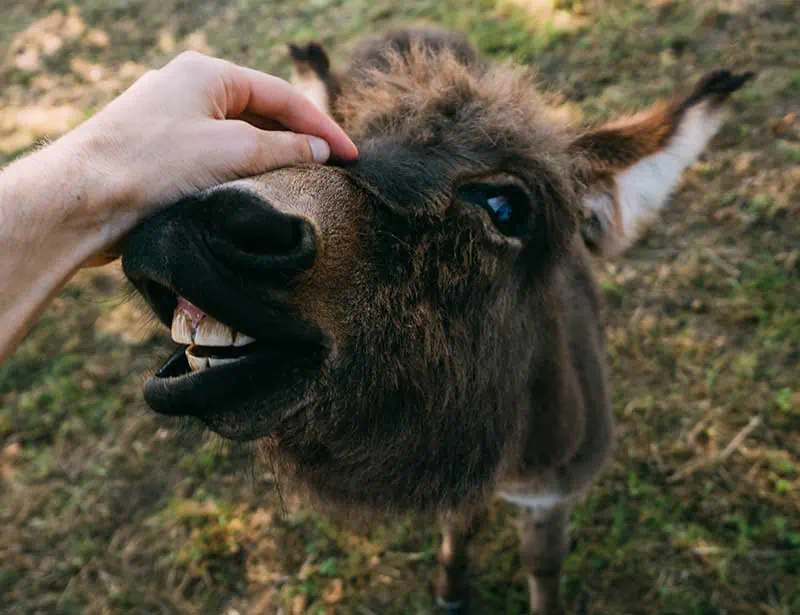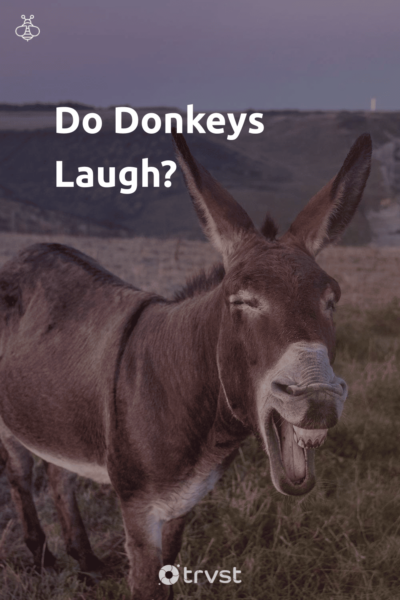Do Donkeys Laugh?
Have you ever wondered, “do donkeys laugh just like humans do?” Donkeys have unique expressions similar to laughing countenance. People always assume that they're laughing or smiling.
The truth is, donkeys cannot laugh or smile.
Scientists refer to laughing traits in an animal as play vocalizations. When these animals experience certain conditions, they display facial expressions and sounds similar to how we might expect them to react were they laughing. Donkeys are one type of animal with animated faces and vocal sounds.
So, if donkeys cannot laugh, why do they have reactions that are like laughing? Read on to understand the expressions they make.
A Donkey's Facial Expression

Donkeys do not actually laugh or smile. People can think they smile because of a particular facial expression they exhibit; they bare their teeth, with their upper lip curling up.
It’s easy to assume that it is a smile, but it is a characteristic behavior of a donkey. You might even think their teethy grin warrants them a place on our list of ugly animals. Other animals like cats, dogs, and rats also exhibit this reaction, called the flehmen's response.
Flehmen's response is not a laugh. It is a behavioral response from animals (mammals and horse families) that involves them lifting their necks, with their upper lips curled up, and baring their teeth. Flehmen’s response is a means for them to transfer smells and pheromones to their olfactory organs.
Inside the olfactory organ is the vomeronasal organ, a secondary olfactory organ located right above the roof of the mouth. The vomeronasal organ contains a pair of tubular diverticula inside the vomer bone.
The vomer bone is within the central portion of the nasal septum4, which can be found in pigs, dogs, horses, donkeys, cats, etc.
They smile when they notice new smells around them and want to get them into their olfactory organs for recognition. Lifting their upper lip helps them transfer the scent directly to their olfactory organs. So whenever you see a donkey smile with its teeth out, there's probably a new smell nearby.
Scientists researched to understand the role of Flehmen's response in stallion behavior. The experiment results showed that donkeys use it to sort through scents, and they can recognize the gender and reproductive status of other stallions by sniffing feces. The Flehmen’s response can also relate to Horses' and donkeys' courting behaviors.
Also, flehmen’s response allows them to have a sense of smell that is 30 times better than that of humans. They smile whenever they smell certain foods, hormones from urine, and feces. However, they don’t smile at every scent.
Here is a fun fact about donkeys before we continue to how they communicate: a male donkey is called a jack or jackass, and a female donkey is called a jenny or jenny.
A Donkey's Vocalisation
Another reason people think donkeys laugh is because of the sound they make. Donkeys make a loud hee-haw sound. The hee-haw sound they make is known as a donkey's bray. They often bray whenever they have a flehmen response. The combination of facial expressions and the sound they make is very similar to human laughing sounds.
Donkeys communicate with each other by braying. It is also how a donkey expresses hunger, anger, and discomfort. Donkeys’ bray and their breathing are linked. The hee-haw sound is in sync with how they inhale and exhale, the hee sound comes when they breathe in, and the haw sound comes when they exhale.
Sometimes, donkeys make different variations of bray sounds. It could be hee-haw or haw-hee, depending on how they breathe. The hee-haw sound always comes with a burst of short breaths. It doesn’t seem like donkeys can control the sounds they produce, but scientists are directing more research towards learning about donkeys’ bray.
Donkeys have loud voice that sometimes sounds brassy. The hee-haw sound they make travels as far as 3km away from their position. Also, donkeys only bray when they know their needs will be heard and sorted. They are tolerant animals, only communicating discomfort in extreme circumstances.
The hee-haw sound is also a way for donkeys to express loneliness and frustration. A professional can recognize the difference in the intent of the series of hee haw displayed by donkeys.
The mechanics that facilitate braying in donkeys are different from that of a horse. The difference between the vocal cords in a horse and a donkey concern their placement and structure accounting for the difference in the sound they make. Although they are families in the horse world, they have varying vocal cords mechanics. A donkey’s vocal cords have lengthier laryngeal saccules. Laryngeal saccules are tissue folds with depressions. They are responsible for producing sound on both sides of the vocal cords.
Other Reasons for Flemen's Response and Braying

Other reasons why donkeys express smiling reactions include:
- Territory
- Post-birth
- Anger
- Hunger
Territory
Donkeys display flehmen responses when they want to mark and protect their territories. Donkeys assert dominance over a domain by defecating and braying. So, donkeys laugh (flehmen response) when they want to determine if a region has a dominant male donkey. Also, donkeys laugh when chasing young male donkeys away from the females.
Mating
Apart from smelling certain foods, donkeys lift their lips in a smile during mating periods. They show their teeth when trying to find out about their female counterpart's reproductive status. They do this by inhaling their pheromones.
Donkeys also show their teeth whenever they want to get the attention of female donkeys in heat. They alternate from sniffing to braying and resting throughout the day.
Anger & Danger
Whenever donkeys display expressions similar to laughing, it might be because they are angry or in imminent danger from predators. Braying is to get the attention of other donkeys and human caretakers, while flehmen's response is a reaction towards understanding their environment through smell. They bray loudly to alert others to the presence of predators in the vicinity, such as lions, wolves, and foxes.
Hunger
They curl their lips and bare teeth to sniff their food before eating. They also make a series of bray sequences to express the need to satisfy their hunger.
What kind of animals laugh?
Research shows that other animals can laugh like humans. When we laugh, it is because we find something funny or feel happy. It's kind of different in animals. Scientists refer to animal laughter as a play vocalization, sounds made during play.
There isn't much information regarding this because there is difficulty determining what play interaction is among animals. The dilemma is in the range of the sounds made. It is difficult to know what vocal sound some animals make because it's low-pitched and often not hearable by human ears.
However, two scientists published a scientific publication that describes social play among animals3. They noted the importance of making play vocalizations in the wild to reach a truce and express excitement, playfulness, and other feelings.
Research results show that up to 65 species of animals display vocalizations similar to laughing. These animals include dogs, cats, pigs, foxes, domestic cows, rats, apes, some species of birds, and other mammals.
A tickle test was performed on rats and some primate species to determine if they actually laughed. The rats made the same chirping sounds they emit during play time during tickling, leading scientists to believe that rats laugh1.
Also, Marina Ross performed a tickle test on young chimpanzees and gorillas to determine if they laughed just like their expressions show2. They all laughed while the scientists tickled them, proving primates laugh. Some researchers claim that human laughter evolved from our ape ancestors in the wild, and out of all these animals, the primate laugh is perhaps closest to our own.
Some animals like hyenas and donkeys don't laugh like they're said to because the sound they make doesn't signal playfulness or comfort. We just assume hyenas and donkeys laugh because their facial expressions resemble laughing characteristics.
Dogs have similar laughing countenances by panting forcefully. It is also called play panting.
Conclusion
Donkeys are not creatures that laugh or smile, but you can refer to their Flehmen response as a smile. Those hee-haws sound like brays with front teeth exhibited by the flehmen response. It can happen during a discomfiting period, like attacks from a predator. Also, donkeys make humorous expressions and loud sounds like a laugh so they can find a female donkey to mate with.
Hopefully, in the future, there will be more research on animal play vocalizations across all species. However, you can still refer to these reactions as a smile or laugh because it's a more familiar description of the actions.
| 1 | Panksepp J, Burgdorf J. 50-kHz chirping (laughter?) in response to conditioned and unconditioned tickle-induced reward in rats: effects of social housing and genetic variables. Behav Brain Res. 2000 Oct;115(1):25-38. doi: 10.1016/s0166-4328(00)00238-2. PMID: 10996405. |
| 2 | Marina Davila Ross, (June 4, 2009). Reconstructing the Evolution of Laughter in Great Apes and Humans. |
| 3 | Sasha L. Winkler & Gregory A. Bryant (2021) Play vocalisations and human laughter: a comparative review, Bioacoustics, 30:5, 499-526, DOI: 10.1080/09524622.2021.1905065 |
| 4 | A. Herbert, S. Janardhan, R. Pandiri, Mark F. Cesta, A. Miller, (2015). Boorman's Pathology of the Rat. |
Jen’s a passionate environmentalist and sustainability expert. With a science degree from Babcock University Jen loves applying her research skills to craft editorial that connects with our global changemaker and readership audiences centered around topics including zero waste, sustainability, climate change, and biodiversity.
Elsewhere Jen’s interests include the role that future technology and data have in helping us solve some of the planet’s biggest challenges.

